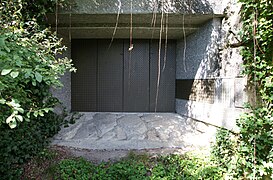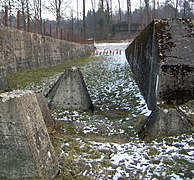Mechanized Division 1
|
Mechanized Division 1 |
|
|---|---|
| active | 1875 to 1994 |
| Country | Switzerland |
The Mechanized Division 1 (Mech Div 1) than the first division a traditional Western Swiss Federation of the Swiss militia army with the main body was of troops from the French-speaking Switzerland and the canton of Bern . It was formed in 1875 due to the new troop order, restructured from 1st Division and Light Brigade 1 to Mech Div 1 in 1962, disbanded in 1994 and replaced by Panzer Brigade 1.

prehistory
In the course of the so-called Napoleon trade between Switzerland and France, the federal troops were mobilized in 1838 : The order of the 1st Division was to occupy the Brugg camp as a permanent garrison . In the Sonderbund War , the 1st Division with 19,000 men took part under Colonel Rilliet de Constant on the side of the federal troops.
With the Federal Constitution of 1848, the cantonal troops began to be combined into a national army. With the partial revision of the Federal Constitution of 1874, the legal basis for the construction, equipment, training and management of a uniform army as well as the division into the army classes extract (20 to 32 years of age) and Landwehr (33 to 44) was created, who had to do a refresher course every two years.
With the troop order of 1911, the previous eight divisions were reduced to six, so that by 1936 the 1st Division consisted of three brigades with two infantry regiments each , Artillery Brigade 1 and over 24,000 militiamen.
First World War
The day after the general mobilization in World War I on August 3, 1914 , the militia divisions moved out to protect the Swiss border (border occupation). The 1st Division was directly available to the general and was mostly stationed in the Jura . According to the Ordre de Bataille of 1917, the war inventory of the 1st Division (including Mountain Brigade 3) was: 949 officers, 24,738 NCOs and soldiers, 6,986 horses, 16,837 rifles, 114 machine guns, 287 sabers, 64 artillery pieces.
Neumühle / Roggenburg border post
Second World War
After mobilization in World War II in September 1939, the 1st Division, subordinate to the 3rd Army Corps , was assigned to the Limmat section of the Dietikon Fortress between the 6th Division (right, east) and the 8th Division (left, west). Their battle positions were prepared by the Dietikon group. The 1st Division remained in western Switzerland for reasons of neutrality policy (between the southern end of Lake Neuchâtel and Lausanne). In the event of an attack, it would have been moved to its Limmat position for six consecutive nights.
The 1st Division under the command of Colonel Divisionary Gustave Combe was reinforced with three infantry battalions (2, 10, 13) and consisted of infantry regiments 2 (Bat 4, 5), 3 (Bat 3, 10, 13, 182), the mountain infantry regiment 7 (Bat 14, 15, 16), the Rifle Battalion 1, the Artillery Regiment 12 (Bat 13, 14, 46). The Dragoon Squadron 25 was probably withdrawn to guard the army headquarters. The command post of the 1st Division (army designation KP Schweizerhof A 1689) was in Gstaad (Oberbort) during active service. It comprised 18,389 men, 483 light machine guns, 129 machine guns on mounts, 204 heavy machine guns, 48 8.1 cm mine launchers, 36 4.7 cm infantry cannons, 36 7.5 cm field cannons, 24 10.5 cm heavy motorized cannons, 12 12 cm field howitzers. On the basis of operational orders 11 and 12 of July 12 and 17, 1940, the 1st Division received the order on July 21 to hold the Gruyères bottleneck and to offer resistance there to the extreme. At the entrance to the Reduite in the area of the cantons of Friborg and Vaud, the 1st Division, which was also subordinated to the Friborg Mountain Fusilier Battalion 17, built the gates of Gruyère , La Tine and Jaun in 1940/41 .
With the operational order No. 13 of May 24, 1941, the 1st Army Corps under Jules Borel received the order to defend the Reduit with the entire western front between Hohgant and Tête Blanche ( Wimmis-Stockhorn blocking point ), to block the upper Aare valley and access to the Protect Réduit in the western pre-Alps. The 1st division under division general Combe received the order, based on the fortress area of Saint-Maurice , to defend the reduit between Rochers de Naye and Kaiseregg ( fortress Euschels ) with the heavyweight along the axes that lead from Bulle into the Simmental .
When the Allied armies marched out of the Rhone Valley along the Swiss border, the divisions left the Reduit in autumn 1944 and were deployed again at the national border.
Cold War
On the basis of the 1961 troop order (TO 61), the Army 61 reform was initiated. The goal was to take into account the threat of the Cold War by increasing the firepower and the mobility of the earth troops as well as modern air defense. The terrain reinforcement in the border area (neutrality protection) was expanded and a new supply organization was supposed to increase sustainability.
The three corps of the field army were renamed field army corps (FAK 1, 2, 3) in 1961 and structured uniformly. Fixed areas of responsibility (basic disposition ZEUS 1992) were assigned to the field army corps and the mountain army corps (Geb. AK 3).
With the formation of three mechanized divisions and the associated increase in the number of battle tanks, the prerequisites for successful combat in the Central Plateau were created, which would make a retreat to the Reduit superfluous.
As the operational reserve of Field Army Corps 1, Mechanized Division 1 conducted its counter-strikes and fought air landings in favor of Field Division 3 in an area that was more extensive and less overbuilt compared to the operational areas of the other two mechanized army units. The area of operation was limited in the north and west by the Jura, in the east by the Emme and in the south by the foothills of the foothills of the Alps.
During the Cold War, the Murten area retained its strategic importance. The Motorized Infantry Regiment 2 of Mechanized Division 1 was intended to occupy the infantry locking bar between its two tank regiments. From January 1987 the factory company 17 was formed in this room, which was directly subordinate to the FAK 1, in order to occupy the partly modernized facilities ( Centi Bunker in Löwenberg).
The Mech Div 1 with the Motorized Infantry Regiment 2 (Mot Inf Rgt 2), the Panzer Regiments 1 and 7 (Pz Rgt 1, 7), as well as the Artillery Regiment 1 (Art Rgt 1) was “the movable element” in the FAK 1's disposition. For the form of defense, the armored formations had to conduct counter attacks against enemy forces. The tank regiments of the Mechanized Divisions were equipped with the Swiss Panzer 61 and, from 1987, retrained to the battle tank 87 "Leopard" .
In their area of operation were the blocking points in Biberenächer , Cudrefin-Vallamand , Faoug , Kleingurmels , Löwenberg , Murten-Mont Vully , Neuenegg - Flamatt and Pratzey .
- Centi bunker A 1175 Löwenberg ⊙
With Army 95 , the mechanized divisions were abolished and the armored forces were combined in the armored brigades. The Panzer Brigade 1 was newly formed from the armored forces of the Mech Div 1. With Army XXI , the tank brigades were reduced from five to two, and tank brigades 2, 3 and 4 were disbanded.
Naming of Mech Div 1 throughout history
- 1875–1911: I. Army Division
- 1911–1936: 1st division
- 1936–1961: 1st division, border division 1st
- 1962–1994: Mech Div 1
External activities and associations
The "Semper fidelis" association was founded in 1971 by former members of the 1st Division and the Light Brigade 1 (dissolved in 2011) and had over 800 members. She was active as a patron and published publications on military writers in western Switzerland.
The French-speaking Swiss daily march (today Marche romande du Général Guisan ) has been organized by the 1st Division since 1965 as a contribution to the many contacts between the French-speaking population and the army.
The Association for Historical Military Plants Freiburg / Bern VH + MA has set itself the goal of maintaining military-historical defense structures as cultural witnesses and for sightseeing.
literature
- Hans-Rudolf Fuhrer: The Swiss Army in the First World War, threats, national defense and national fortifications . NZZ-Verlag, Zurich 1999/2003, ISBN 3-03823-018-9 .
- D. Jordan, H. de Weck: The Mech Div 1 in the anniversary year. ASMZ issue 6, volume 153 1987
Web links
Individual evidence
- ↑ DDPS: Panzerbrigade 1 ( Memento from January 26, 2016 in the Internet Archive )
- ^ Bruno Uebel: Course of tactics and strategy and plan for the defense of Switzerland against France in 1838 . Publishing house of the literary comptoir, Zurich and Winterthur 1842
- ↑ Max Schafroth, Edgar Schumacher: 100 Years of the Swiss Wehrmacht . Hallwag Publishing House, Bern 1939
- ↑ Structure of the 6 divisions of the Swiss Army, “Ordre de Bataille” from 1917
- ^ Limmat position of the 1st division
- ^ La 1re Division, un fantôme de la Limmatstellung (1939-1940)
- ^ Military monuments in the cantons of Bern and Friborg, VEB 2006
- ↑ Fortress Oberland: Biberenächer
- ↑ Military and Civil Protection , Canton Solothurn: Reminder plaques for Solothurn 4-er associations. Solothurn June 2011
- ^ Ligue vaudoise: Semper Fidelis 1971-2011
- ↑ Le courrier of June 18, 2015: Marche romande du Général Guisan
- ^ Association of Historical Military Facilities Freiburg / Bern VH + MA
- ↑ D. Jordan, H. de Weck: The Mech Div 1 in the anniversary year. ASMZ issue 6, volume 153 1987
Coordinates: 46 ° 56 '20.4 " N , 7 ° 8' 15.8" E ; CH1903: 577088 / one hundred and ninety-eight thousand seven hundred and one










